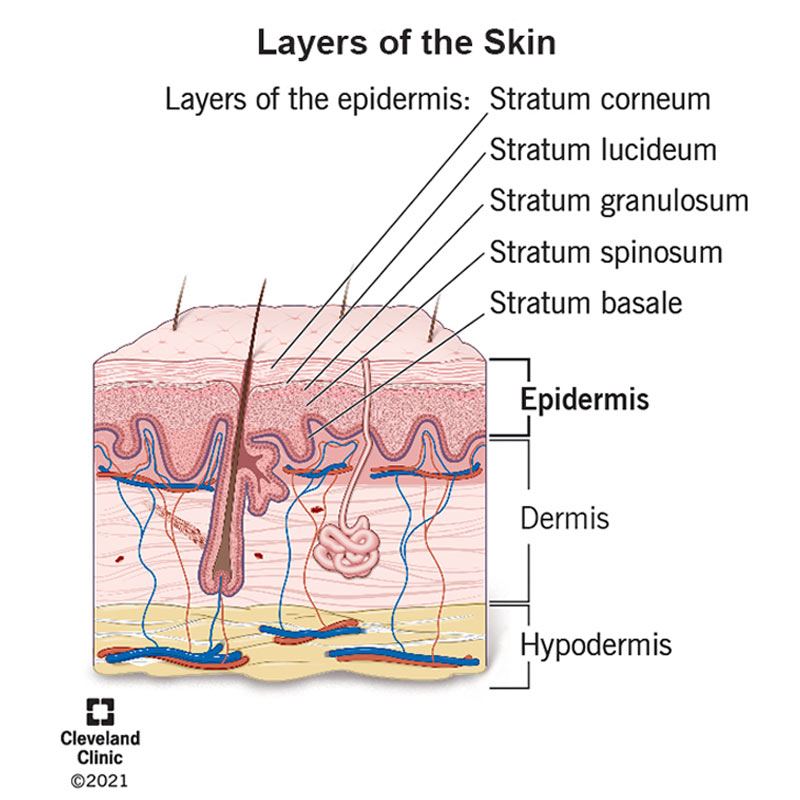Your epidermis is the outermost layer of skin on your body. It protects your body from harm, keeps your body hydrated, produces new skin cells and contains melanin, which determines the color of your skin.
Advertisement
Cleveland Clinic is a non-profit academic medical center. Advertising on our site helps support our mission. We do not endorse non-Cleveland Clinic products or services. Policy

Your skin has three main layers, and the epidermis (ep-uh-derm-us) is the outermost layer in your body. The other two layers of skin are the dermis and hypodermis. The epidermis is the thinnest layer of skin, but it’s responsible for protecting you from the outside world, and it’s composed of five layers of its own.
Advertisement
Cleveland Clinic is a non-profit academic medical center. Advertising on our site helps support our mission. We do not endorse non-Cleveland Clinic products or services. Policy
The layers of the epidermis in order are:
Advertisement
The word “epidermis” combines the Ancient Greek prefix epi-, which means “outer,” and the Ancient Greek word derma, which means “skin.” So the word translates to “outer skin.”
The epidermis and the dermis are the top two layers of skin in your body. The epidermis is the top layer, and the dermis is the middle layer. The dermis exists between the epidermis and the hypodermis.
While the epidermis is the thinnest layer of skin, the dermis is the thickest layer of skin. The dermis contains collagen and elastin, which help make it so thick and supportive of your skin’s overall structure.
All of your connective tissues, nerve endings, sweat glands, oil glands and hair follicles exist in the dermis as well as the hypodermis.
Each layer of your skin works together to keep your body safe, including your skeletal system, organs, muscles and tissues. The epidermis has many additional functions, including:
In conjunction with your other layers of skin, the epidermis protects your skeletal system, organs, muscles and tissues from harm.
The epidermis is the top layer of your skin, and it’s what you see or feel when you look at or touch another person.
Melanocyte cells make melanin, which is a natural skin pigment that determines the color of your skin. Melanocytes produce two types of melanin that help determine how much pigment you have:
The epidermis varies in thickness throughout your body. In areas of skin that experience a lot of use, like the soles of your feet and the palms of your hands, the epidermis is thicker. These areas can be as thick as 1.5 millimeters, which is about as thick as two credit cards stacked together.
The epidermis is thinner in other areas of your face. For example, the epidermis layer in your eyelids is about 0.05 millimeters thick, which is about as thick as a sheet of copy paper.
Advertisement
The epidermis contains different types of cells, including:
Some common conditions and disorders that affect the epidermis include:
Some common signs or symptoms of conditions that can affect your epidermis include:
Your healthcare provider will conduct a physical exam of your epidermis to check for any possible symptoms or conditions. They may also perform the following tests:
If you have melanoma, you may need further imaging tests to determine if it has spread.
Some common treatments for conditions that affect your epidermis include:
Advertisement
The epidermis is the top layer of skin in your body. It has many important functions, including protecting your body from the outside world, keeping your skin hydrated, producing new skin cells and determining your skin color. It’s important to take care of your epidermis. You can help take care of your skin by drinking plenty of water, eating antioxidant-rich foods and regularly using sunscreen with an SPF of at least 30.
Advertisement
Cleveland Clinic’s primary care providers offer lifelong medical care. From sinus infections and high blood pressure to preventive screening, we’re here for you.

Last reviewed on 10/19/2021.
Learn more about the Health Library and our editorial process.